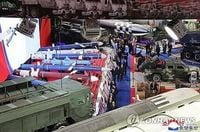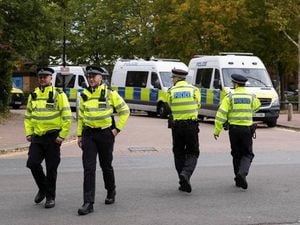North Korea’s capital, Pyongyang, was abuzz on October 4, 2025, as the country’s leadership, military brass, and scientific elite gathered for the grand opening of the annual Defence Development-2025 exhibition. The event, which has now become a fixture in the North Korean calendar for three consecutive years, took on added significance this year, coinciding with the 80th anniversary of the founding of the Workers’ Party of Korea—a milestone deeply woven into the nation’s political identity.
At the heart of the exhibition was North Korean leader Kim Jong Un, who presided over the opening ceremony with characteristic zeal. According to the Korean Central News Agency (KCNA), Kim delivered a keynote speech that underscored the regime’s steadfast commitment to modernizing its military might. He placed particular emphasis on the importance of nuclear capabilities, describing them as the “core pillar” of the country’s defense strategy. The event wasn’t just a display of hardware; it was a showcase of national resolve and technological ambition.
The Defence Development-2025 exhibition itself was a testament to North Korea’s evolving self-image as a nation determined to chart its own course in defense innovation. The halls of the exhibition brimmed with upgraded weapons systems, sleek new military equipment, and, perhaps most notably, technologies that harness artificial intelligence for defense applications. The event drew not only top government officials and military leaders but also scientists, engineers, and educators from the country’s defense academies—a sign of the regime’s desire to present its advancements as a collective national achievement.
“These advances reflect North Korea’s strength and spirit of self-reliance in developing its defense industry,” Kim Jong Un declared, as reported by KCNA. The phrase “strength and spirit of self-reliance” is no throwaway line in Pyongyang; it’s a core tenet of the Juche ideology that has defined the nation’s political and economic outlook for decades. For Kim, the exhibition was as much about sending a message to the world as it was about rallying his own people.
The timing of the exhibition was carefully chosen. Held on the eve of the Workers’ Party’s 80th anniversary, the event was steeped in symbolism. The party, founded in 1945, has been the engine of North Korea’s political life, and its legacy is inseparable from the Kim family’s rule. The exhibition thus served a dual purpose: celebrating the party’s storied history and projecting a vision of a technologically advanced, militarily robust future.
Kim Jong Un’s remarks at the opening ceremony were unambiguous. He highlighted the rapid progress made in the defense sector, noting that “in less than one year, the defense industry achieved significant progress in weapons development and adoption of new technologies.” This claim, echoed across North Korean state media and reported by outlets such as Yonhap, was intended to demonstrate that the nation’s defense industry is not only keeping pace with global trends but, in some areas, setting its own benchmarks.
The exhibition’s array of modern weaponry and AI-driven systems was designed to impress both domestic and international audiences. While the specifics of many systems remain shrouded in secrecy—typical for North Korea’s tightly controlled information environment—the message was clear: the country is leveraging cutting-edge technology to bolster its military power. According to KCNA, the inclusion of artificial intelligence in defense applications is one of the most significant recent achievements, signaling a willingness to embrace innovations that are reshaping military doctrines worldwide.
But it wasn’t all about technology. The event was also a celebration of North Korea’s capacity for “self-reliant defense development,” as highlighted by the country’s official news agencies. This narrative of self-sufficiency is a recurring theme in North Korean statecraft, particularly in the face of international sanctions and diplomatic isolation. By showcasing homegrown advancements, the leadership seeks to reinforce the notion that the nation can stand on its own, regardless of external pressures.
The exhibition drew a diverse crowd, including government officials, high-ranking military officers, scientists, engineers, and even teachers and students from military academies. This broad participation was no accident. It reflected the regime’s desire to portray its defense achievements as the result of a united national effort—one that draws on the talents and dedication of all sectors of society.
Kim Jong Un’s speech also served as a rallying cry for continued innovation. “We are promoting modernization projects and enhancing military power, with nuclear forces considered a fundamental pillar,” he stated, according to KCNA. The emphasis on nuclear deterrence is hardly new in North Korean rhetoric, but its repetition at such a high-profile event signals the regime’s intent to double down on this strategy, even as it experiments with new technologies like AI.
The exhibition also provided an opportunity for North Korea to send signals beyond its borders. Just days before the event, on October 2, the North Korean embassy in Hanoi hosted a reception marking the Workers’ Party’s 80th anniversary, underlining the regime’s efforts to maintain and strengthen diplomatic ties, particularly with neighboring China. Kim Jong Un himself recently declared his intention to “promote relations with China even more strongly,” as reported by KCNA. These gestures suggest that, while North Korea remains focused on self-reliance, it is not turning its back on international partnerships entirely—especially those that can bolster its strategic position.
The rapid pace of North Korea’s military modernization has not gone unnoticed in the region. While the exhibition was framed as a celebration of national achievement, it also carried an implicit warning to rivals and skeptics: North Korea intends to remain a formidable military power, whatever the challenges. The country’s leadership is acutely aware that its security environment is fraught with uncertainty, and it is responding by investing in every available means of deterrence and defense.
For the outside world, the Defence Development-2025 exhibition offered a rare glimpse into the priorities and ambitions of one of the world’s most secretive regimes. The blend of traditional military hardware and futuristic technologies like artificial intelligence suggests a willingness to innovate, even as the regime clings to its longstanding doctrines. Whether these advancements will translate into lasting strategic advantages remains to be seen, but for now, North Korea is determined to showcase its progress—and its resilience—on its own terms.
As the exhibition drew to a close, the message from Pyongyang was unmistakable: North Korea sees itself as a nation on the rise, guided by a sense of mission and a belief in its own capabilities. In a world where military technology is evolving at breakneck speed, the country is determined not to be left behind. For Kim Jong Un and his government, the Defence Development-2025 exhibition was more than a display of weapons—it was a declaration of intent.




